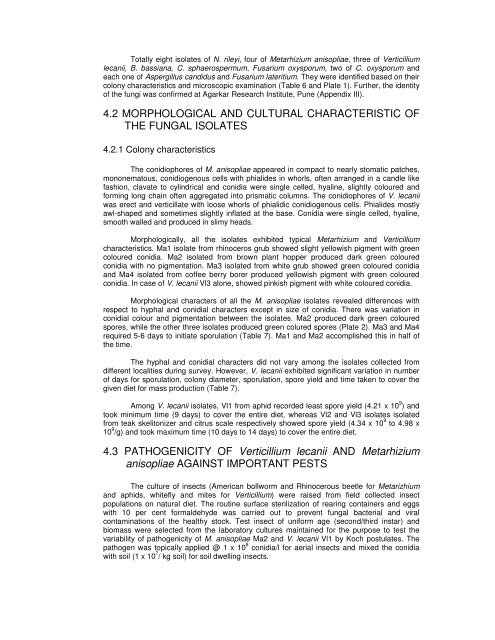ISOLATION AND CHARACTERIZATION OF ENTOMOPATHOGENIC ...
ISOLATION AND CHARACTERIZATION OF ENTOMOPATHOGENIC ...
ISOLATION AND CHARACTERIZATION OF ENTOMOPATHOGENIC ...
Create successful ePaper yourself
Turn your PDF publications into a flip-book with our unique Google optimized e-Paper software.
Totally eight isolates of N. rileyi, four of Metarhizium anisopliae, three of Verticillium<br />
lecanii, B. bassiana, C. sphaerospermum, Fusarium oxysporum, two of C. oxysporum and<br />
each one of Aspergillus candidus and Fusarium lateritium. They were identified based on their<br />
colony characteristics and microscopic examination (Table 6 and Plate 1). Further, the identity<br />
of the fungi was confirmed at Agarkar Research Institute, Pune (Appendix III).<br />
4.2 MORPHOLOGICAL <strong>AND</strong> CULTURAL CHARACTERISTIC <strong>OF</strong><br />
THE FUNGAL ISOLATES<br />
4.2.1 Colony characteristics<br />
The conidiophores of M. anisopliae appeared in compact to nearly stomatic patches,<br />
mononematous, conidiogenous cells with phialides in whorls, often arranged in a candle like<br />
fashion, clavate to cylindrical and conidia were single celled, hyaline, slightly coloured and<br />
forming long chain often aggregated into prismatic columns. The conidiophores of V. lecanii<br />
was erect and verticillate with loose whorls of phialidic conidiogenous cells. Phialides mostly<br />
awl-shaped and sometimes slightly inflated at the base. Conidia were single celled, hyaline,<br />
smooth walled and produced in slimy heads.<br />
Morphologically, all the isolates exhibited typical Metarhizium and Verticillium<br />
characteristics. Ma1 isolate from rhinoceros grub showed slight yellowish pigment with green<br />
coloured conidia. Ma2 isolated from brown plant hopper produced dark green coloured<br />
conidia with no pigmentation. Ma3 isolated from white grub showed green coloured conidia<br />
and Ma4 isolated from coffee berry borer produced yellowish pigment with green coloured<br />
conidia. In case of V. lecanii Vl3 alone, showed pinkish pigment with white coloured conidia.<br />
Morphological characters of all the M. anisopliae isolates revealed differences with<br />
respect to hyphal and conidial characters except in size of conidia. There was variation in<br />
conidial colour and pigmentation between the isolates. Ma2 produced dark green coloured<br />
spores, while the other three isolates produced green colured spores (Plate 2). Ma3 and Ma4<br />
required 5-6 days to initiate sporulation (Table 7). Ma1 and Ma2 accomplished this in half of<br />
the time.<br />
The hyphal and conidial characters did not vary among the isolates collected from<br />
different localities during survey. However, V. lecanii exhibited significant variation in number<br />
of days for sporulation, colony diameter, sporulation, spore yield and time taken to cover the<br />
given diet for mass production (Table 7).<br />
Among V. lecanii isolates, Vl1 from aphid recorded least spore yield (4.21 x 10 9 ) and<br />
took minimum time (9 days) to cover the entire diet, whereas Vl2 and Vl3 isolates isolated<br />
from teak skelitonizer and citrus scale respectively showed spore yield (4.34 x 10 9 to 4.98 x<br />
10 9 /g) and took maximum time (10 days to 14 days) to cover the entire diet.<br />
4.3 PATHOGENICITY <strong>OF</strong> Verticillium lecanii <strong>AND</strong> Metarhizium<br />
anisopliae AGAINST IMPORTANT PESTS<br />
The culture of insects (American bollworm and Rhinocerous beetle for Metarizhium<br />
and aphids, whitefly and mites for Verticillium) were raised from field collected insect<br />
populations on natural diet. The routine surface sterilization of rearing containers and eggs<br />
with 10 per cent formaldehyde was carried out to prevent fungal bacterial and viral<br />
contaminations of the healthy stock. Test insect of uniform age (second/third instar) and<br />
biomass were selected from the laboratory cultures maintained for the purpose to test the<br />
variability of pathogenicity of M. anisopliae Ma2 and V. lecanii Vl1 by Koch postulates. The<br />
pathogen was topically applied @ 1 x 10 8 conidia/l for aerial insects and mixed the conidia<br />
with soil (1 x 10 7 / kg soil) for soil dwelling insects.
















